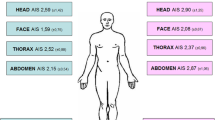Abstract
Purpose
The suicidal attempt is a significant cause for multiple severe injuries in Germany. The aim of the present study was to obtain information regarding injury patterns, clinical treatment, and outcome.
Methods
We analyzed the data of 4,754 patients of the Trauma Registry of the German Trauma Society (1993–2007) with an Injury Severity Score (ISS) ≥9 after a suicidal jump from a height (SUICIDE) and after an accidental fall from a height (ACCIDENT).
Results
Comparing the data of 3,682 patients with accidental fall versus those with intentional fall/jump (n = 1,072), we found that male patients were predominant in the ACCIDENT group (84.9 vs. 52.2%). The SUICIDE group had more severe injuries (ISS: 31.8 vs. 26.4). The ACCIDENT group suffered more severe head injuries (51.1 vs. 36.6%). Mortality (21.4 vs. 14.2%), length of stay in hospital (29.5 vs. 26.5 days), and costs (€34,833 vs. €24,701) were higher in the SUICIDE group.
Conclusions
Falls from a height are a common cause of injury among severely injured patients. The resulting trauma composes a particular form of blunt trauma with severe and multiple injuries, which depends on the fact of whether the free fall from a height was caused by an accident or as a result of a suicidal attempt. Taking the injury severity into consideration, there is no difference in the prognosis of the patients.





Similar content being viewed by others
References
Kühne CA, Ruchholtz S, Buschmann C, Sturm J, Lackner CK, Wentzensen A, Bouillon B, Waydhas C, Weber C; AG Polytrauma DGU. Trauma centers in Germany. Status report. Unfallchirurg. 2006;109:357–66.
Liener UC, Rapp U, Lampl L, Helm M, Richter G, Gaus M, Wildner M, Kinzl L, Gebhard F. Incidence of severe injuries. Results of a population-based analysis. Unfallchirurg. 2004;107:483–90.
Juhra C, Franz D, Roeder N, Vordemvenne T, Raschke MJ. Classification of severely injured patients in the G-DRG System 2008. Unfallchirurg. 2009;112:525–32.
Statistisches Bundesamt Deutschland (2007).
Schmidtke A, Bille-Brahe U, DeLeo D, Kerkhof A, Bjerke T, Crepet P, Haring C, Hawton K, Lönnqvist J, Michel K, Pommereau X, Querejeta I, Phillipe I, Salander-Renberg E, Temesváry B, Wasserman D, Fricke S, Weinacker B, Sampaio-Faria JG. Attempted suicide in Europe: rates, trends and sociodemographic characteristics of suicide attempters during the period 1989–1992. Results of the WHO/EURO Multicentre Study on Parasuicide. Acta Psychiatr Scand. 1996;93:327–38.
Hadjizacharia P, Brown CV, Teixeira PG, Chan LS, Yang K, Salim A, Inaba K, Rhee P, Demetriades D. Traumatic suicide attempts at a level I trauma center. J Emerg Med. 2010;39:411–8
Richter D, Hahn MP, Ostermann PA, Ekkernkamp A, Muhr G. Vertical deceleration injuries: a comparative study of the injury patterns of 101 patients after accidental and intentional high falls. Injury. 1996;27:655–9.
Teh J, Firth M, Sharma A, Wilson A, Reznek R, Chan O. Jumpers and fallers: a comparison of the distribution of skeletal injury. Clin Radiol. 2003;58:482–6.
Ruchholtz S. The Trauma Registry of the German Society of Trauma Surgery as a basis for interclinical quality management. A multicenter study of the German Society of Trauma Surgery. Unfallchirurg. 2000;103:30–7.
Lefering R. Development and validation of the Revised Injury Severity Classification score for severely injured patients. Eur J Trauma Emerg Surg. 2009;35:437–47.
Pape HC, Grotz M, Schwermann T, Ruchholtz S, Lefering R, Rieger M, Tröger M, Graf von der Schulenburg JM, Krettek C; AG Polytrauma der DGU. The development of a model to calculate the cost of care for the severely injured—an initiative of the Trauma Register of the DGU. Unfallchirurg. 2003;106:348–57.
Böstman OM. Suicidal attempts by jumping from heights. A three-year prospective study of patients admitted to an urban university accident department. Scand J Soc Med. 1987;15:119–203.
Etzersdorfer E, Voracek M, Kapusta N, Sonneck G. Epidemiology of suicide in Austria 1990–2000: general decrease, but increased suicide risk for old men. Wien Klin Wochenschr. 2005;117:31–5.
Dzupa V, Chmelová J, Pavelka T, Obruba P, Wendsche P, Simko P. Multicentric study of patients with pelvic injury: basic analysis of the study group. Acta Chir Orthop Traumatol Cech. 2009;76:404–9.
Isbister ES, Roberts JA. Autokabalesis: a study of intentional vertical deceleration injuries. Injury. 1992;23:119–22.
Mathis RD, Levine SH, Phifer S. An analysis of accidental free falls from a height: the ‘spring break’ syndrome. J Trauma. 1993;34:123–6.
Aufmkolk M, Majetschak M, Voggenreiter G, Obertacke U, Schmit-Neuerburg KP. Follow-up and prognosis of severe accidental trauma in the aged. Unfallchirurg. 1997;100:477–82.
Katz K, Gonen N, Goldberg I, Mizrahi J, Radwan M, Yosipovitch Z. Injuries in attempted suicide by jumping from a height. Injury. 1988;19:371–4.
Ruchholtz S, Nast-Kolb D, Waydhas C, Schweiberer L. The injury pattern in polytrauma. Value of information regarding accident process in clinical acute management. Unfallchirurg. 1996;99:633–41.
Ruchholtz S, Pajonk FG, Waydhas C, Lewan U, Nast-Kolb D, Schweiberer L. Long-term results and quality of life after parasuicidal multiple blunt trauma. Crit Care Med. 1999;27:522–30.
Warner KG, Demling RH. The pathophysiology of free-fall injury. Ann Emerg Med. 1986;15:1088–93.
Schmelz A, Ziegler D, Beck A, Kinzl L, Gebhard F. Costs for acute, stationary treatment of polytrauma patients. Unfallchirurg. 2002;105:1043–8.
Schwermann T, Grotz M, Blanke M, Ruchholtz S, Lefering R, V d Schulenburg JM, Krettek C, Pape HC. Evaluation of costs incurred for patients with multiple trauma particularly from the perspective of the hospital. Unfallchirurg. 2004;107:563–74.
Conflict of interest
All authors declare no conflicts of interest.
Author information
Authors and Affiliations
Consortia
Corresponding author
Rights and permissions
About this article
Cite this article
Topp, T., Müller, T., Kiriazidis, I. et al. Multiple blunt trauma after suicidal attempt: an analysis of 4,754 multiple severely injured patients. Eur J Trauma Emerg Surg 38, 19–24 (2012). https://doi.org/10.1007/s00068-011-0114-5
Received:
Accepted:
Published:
Issue Date:
DOI: https://doi.org/10.1007/s00068-011-0114-5




